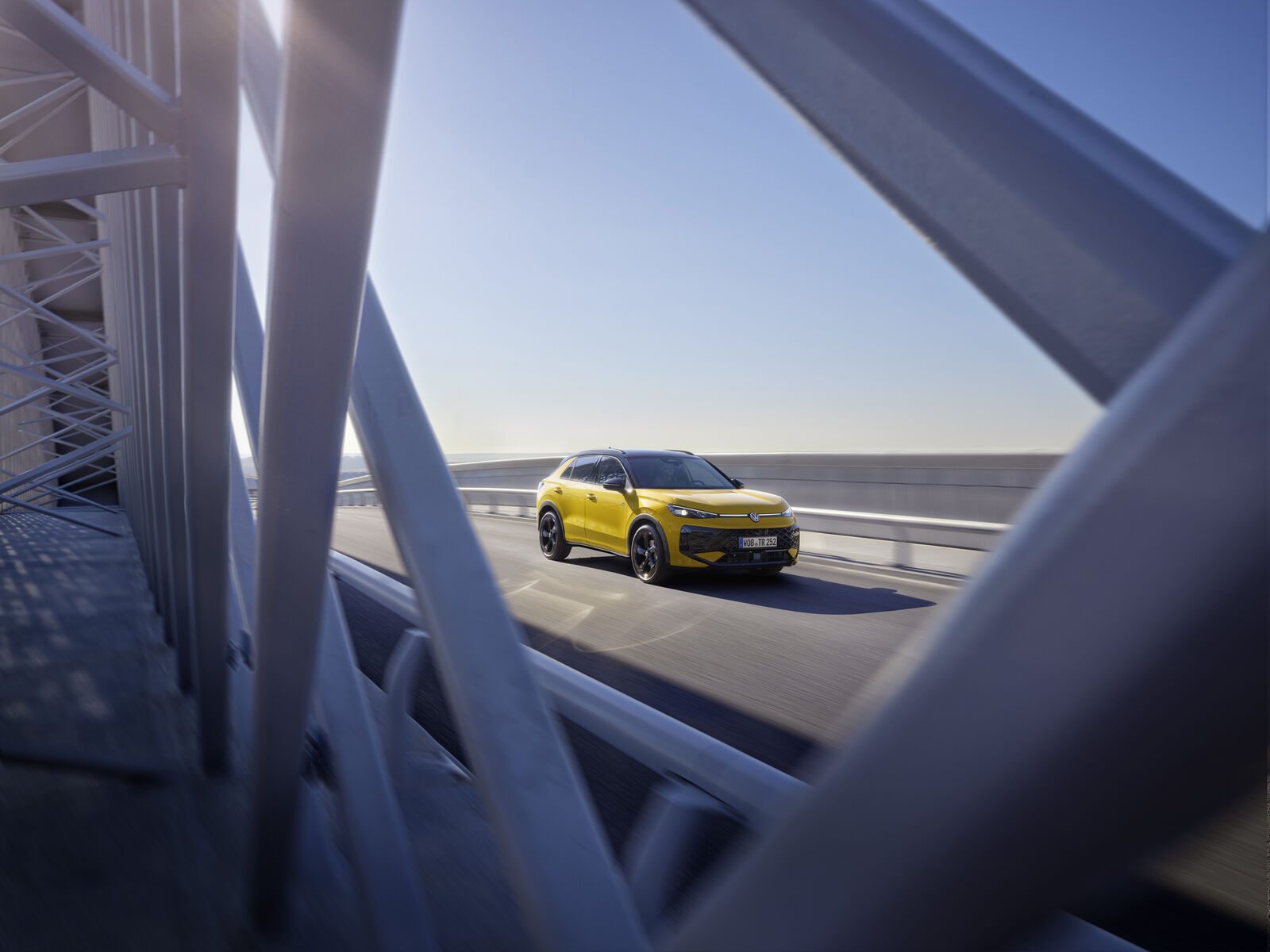Top-down technology. Together with the Taigo, T-Cross, Tiguan, Tayron and Touareg, the T-Roc is a member of one of the largest families of SUV vehicles in Europe. Positioned between the more compact T-Cross and the larger Tiguan, the T-Roc has not only become one of the most successful Volkswagen models since 2017, but also one of the Group’s best-selling models year-on-year. Now in its second generation, the five-seater SUV all-rounder has the potential to further build on its position within the brand, the Group and the wider competitive environment. So, why is that? Following on from the latest Tiguan (debut in 2024) and Tayron (debut in 2025), the new T-Roc is the third Volkswagen SUV to be based on the latest stage in the evolution of the modular transverse matrix: the MQB evo. And that’s what sets it apart. Thanks to the MQB evo, the T-Roc brings a new level of technology to the compact SUV segment. It adopts numerous “top-down” systems from the larger Tiguan and Tayron and has the same quality as these Volkswagen models. The new T-Roc is also a pioneer in terms of sustainability: Around 20 per cent of all plastics in the vehicle are made from recycled materials, which is equivalent to a weight of up to 40 kg. The T-Roc is the first Volkswagen to achieve such a high proportion of recycled materials.
Hybrid as standard. In Europe, the new T-Roc is powered by innovative hybrid turbocharged petrol engines across the board, while automatic transmissions take care of gear changes. For the launch, there are two 48V mild hybrid drives (eTSI) with 85 kW (116 PS) and 110 kW (150 PS). These two electrified high-volume engines are coupled to a 7-speed direct shift gearbox (DSG). They will then be followed by two full hybrid drive systems that have been developed from scratch. The front-wheel drive is common to all four drive variants. As with the previous model, the new T-Roc will again be available with 4MOTION all-wheel drive at a later date – combined with the 2.0-litre TSI, which will also be offered as a mild hybrid (mHEV) in the future.
Some important extra millimetres. The ideal ratio between the compact exterior dimensions and the superior five-seater and thus fully family-friendly interior is one of the reasons why more than two million units of the first-generation T-Roc were sold. And this ratio has become even better in the new T-Roc. At 4,373 mm, the second generation is exactly 122 mm longer than its predecessor; the wheelbase has also increased and spans 2,631 mm (+28 mm) between the alloy wheels, which now measure up to 20 inches (previously up to 19 inches). This increase benefits the space available inside the T-Roc.
Design statement. The elongated proportions also have a positive effect on the even more dynamic design. The predecessor already had its own hallmark design style. These stylistic features include a striking silver stripe that extends from the A-pillar to the D-pillar. The designers called this a “hockey stick” due to its shape. Another archetypal feature was the muscular and powerful shoulder section above the rear wheel arch. As part of the model series’ DNA, these features have also been incorporated into the successor’s new design. So, despite its redesign and enhancements, this makes it immediately recognisable as a T-Roc – right down to the very last millimetre. However, enhancing a design also involves having the courage to combine the DNA of a best-seller with brand-new elements, and thus take it into a new era. The front of the new T-Roc does exactly that: The “face” now showcases a stylistic relationship with the family of other current Volkswagens, such as the Tayron and ID.7. But for the T-Roc, this has resulted in its own ‘product face’ and thus a new original. The lighting design also plays an essential role in the new interpretation of the T-Roc. The LED headlights at the front are entirely new. In the highest equipment specification, innovative IQ.LIGHT LED matrix headlights are on board, which – like the LED Plus headlights standard in the higher equipment packages – are linked by a narrow strip of LEDs and the illuminated VW logo. The rear has also been completely redesigned with its full-length LED strip, which is also illuminated in the middle in the higher equipment lines, where it also features a red illuminated VW logo.
Interior bridges the gap to the next class up. The new T-Roc also takes a big step forward in its interior, breaking the conventional class boundaries with its high-quality materials, progressively clean design and innovative technologies. A visual and tactile feature of this leap in quality is the newly developed fabric structure on the surface of the dashboard. The fabric creates a lounge-like atmosphere and is a visible manifestation of the high quality of the T-Roc. At the same time, the stylishly clean interior design creates a particularly clear and cosy ambience. What’s more, the deliberate decision to omit classic decorative elements leads to a neat, tidy interior that emphasises the value of the details – such as the background lighting that illuminates the interior through perforated leatherette surfaces for the first time in a Volkswagen. Another focus during the T-Roc’s development was ergonomic operation. This is why the door openers have been redesigned, for example: Integrated into the front armrests of the doors, the driver and passengers automatically grasp the aesthetic silver-black handles and intuitively pull them upwards to open – “Form follows function” in the purest sense. The new T-Roc also adopts a number of details from the larger Tiguan and Tayron – such as the latest evolution of the driving experience control (e.g. for controlling driving profiles and volume levels). Another novelty in this class is the optional windscreen head-up display1 for the T-Roc. Features such as the new Digital Cockpit Pro in large rectangular format are available for user-oriented technologies. In addition to the usual “views”, it offers a completely stripped-back display for the first time, as the full spectrum of information is not always required.
Five-seat all-rounder. Anyone who sits in the driver or front passenger seat of the T-Roc and gazes across its elegant cockpit landscape and over the high bonnet will not necessarily imagine they are sitting in a SUV in the more compact class. This impression is reinforced by the space offered by the second-generation T-Roc, which is suitable for long-distance journeys and families. Even if people taller than 1.85 m are seated in the front, passengers of a similar stature can comfortably sit in the rear thanks to the extra 122 mm added to the length of the new T-Roc. In addition, an electrically adjustable 14-way ergoActive seat with massage function will be available in the top Style version for the first time in the T-Roc. Volkswagen has thus transferred a feature from the mid-range and luxury class to the T-Roc segment. Thanks Seating comfort in the new T-Roc is now in a league of its own. In addition, the designers have also ensured that there is plenty of space for five passengers’ worth of luggage: Thanks to longer length, the luggage compartment volume has now increased by 30 litres to 475 litres when loaded up to the height of the rear seat backrests.
Technology transfer thanks to MQB evo. For many decades, Volkswagen has been bringing progress to the masses and thus also the safety and comfort of its vehicles. The new T-Roc is yet another example of an approach that uses economies of scale and synergies between individual model series to enable Volkswagen to offer technical innovations in all of its segments. This is because the second generation of the best-selling SUV is based on the MQB evo – the latest stage in the evolution of the modular transverse matrix, a modular technology system whose systems are also used in the large Tayron or the mid-range best-seller Passat. As the latest MQB-evo model series, the T-Roc now benefits from all the hardware and software developments from this modular system. This includes a new version of Travel Assist, which now not only supports automatic lane changes, but also reacts with even more foresight to upcoming speed limits or the lifting of speed limits. In addition, the new T-Roc is also for the first time equipped with systems such as Park Assist Pro, which enables trained and thus fully automatic parking over distances of up to 50 metres via the memory function and allows a smartphone to be used to drive the vehicle in and out of parking spaces. Another new feature on board is the exit warning system, which can warn occupants before opening the doors if cars or bicycles are approaching from behind.
Trend, Life, Style and R-Line. The T-Roc’s equipment matrix is clearly structured and customer-oriented. In order to make configuration as simple as possible, Volkswagen has combined standard and optional individual features and packages with the four equipment versions, enabling customers to combine them in accordance with their preferences. The programme consists of the basic “Trend” version (focus on budget & functionality), the first expansion package “Life” (focus on functionality and comfort) as well as the two top-of-the-line versions “Style” (focus on design & technology) and “R-Line” (focus on sportiness). From the “Life” equipment specification and above, all models are available with a bi-colour paint finish – a hallmark feature of the T-Roc. Details such as adaptive chassis control, a sound system from Harman Kardon and a Black Style package with black exterior details including black alloy wheels will be added to the range of exclusive optional equipment for the T-Roc Style and T-Roc R-Line. All versions of the T-Roc can be ordered with a towing bracket whose drawbar load is also designed for transporting heavy e-bikes. The new T-Roc can be configured in six colours: Pure White solid, Wolf Grey metallic as well as the new paint colours Canary Yellow solid, Flamed Red metallic, Celestial Blue metallic and Grenadilla Black metallic. The roof is also available in the bi-colour Black Solid colour.










